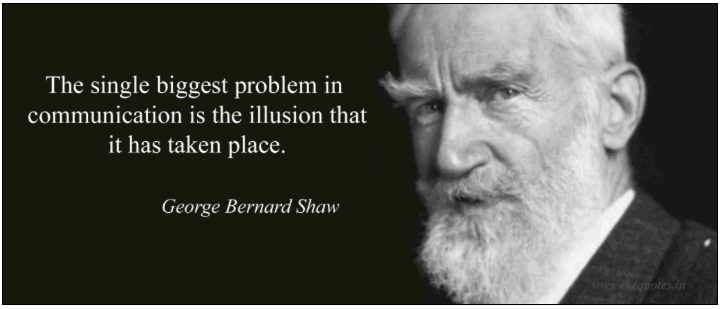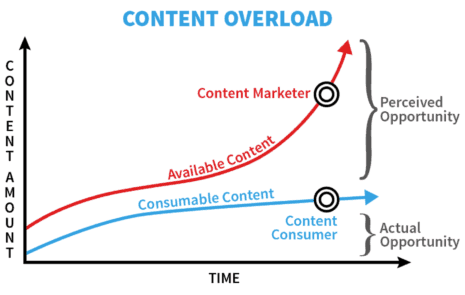
“How to best engage people with content marketing from the start?”
How to engage people in content marketing from the start.
A marketer from Hiscox, a business insurance firm, asked this question about content marketing, “What are the best practices for engaging your audience in the beginning phase?” It’s one of the Top 100 Questions on content marketing.
When you first get to know any audience, these principles will serve you well. Since Hiscox markets to businesses, this blog focuses on a business-to-business (B2B) content-marketing approach.
Listen with humanity and probe people’s needs

Do everything possible to get the voice of real customers in your ear. Go on sales calls, do telephone interviews, and meet with customers at trade shows or other events.
Commission buyer persona research to find out what prospects and customers are feeling and thinking when they buy a service or product like yours:
- What do they need from the service or product?
- Which scenarios do they envision that your product or service will change?
- What are their questions and where do they hunt for information?
- What obstacles do they need to overcome?
Buyer persona research gives a human voice to real people.
Your buyer persona research should consist of 10 or more interviews with real prospects and customers, by phone or in person. It should include people who bought from your brand and did not buy from your brand – people who got stuck in the buying journey or chose a competitor.
Buyer persona research provides insights into what customers are doing when they’re offstage, out of sight for marketing and sales.
As you analyze buyer persona interviews, be sure to listen closely to the emotion behind your customers’ words. Remember that people make decisions, even big-ticket B2B decisions, based more on their emotions than on facts.
That’s why it’s not sufficient to hit B2B buyers with facts, figures, and specs. To move them takes emotion. Market to humans first, then address their business needs.
Emphasize benefits over features, feelings over facts
Why? Because humans are feeling machines that think, not thinking machines that feel. We reach decisions in intuitive, emotional ways to engage people with content marketing from the start.
As Michael D. Harris observes in the Harvard Business Review, “I’d argue that too often, selling to Mr. Rational leads to analysis paralysis, especially for complex products or services. And yet many of us continue to market almost exclusively to Mr. Rational.
The result is that we spend too much time chasing sales opportunities that eventually stall out. We need to improve our ability to sell to Mr. Intuitive.
“We default to selling to Mr. Rational because when we think of ourselves, we identify with our conscious rational mind. We can’t imagine that serious executives would make decisions based on emotion because we view our emotional decisions as irrational and irresponsible.
“But what if Mr. Intuitive has a logic of his own? In recent years, psychologists and behavioral economists have shown that our emotional decisions are neither irrational nor irresponsible.
In fact, we now understand that our unconscious decisions follow a logic of their own. They are based on a deeply empirical mental processing system that is capable of effortlessly processing millions of bits of data without getting overwhelmed. Our conscious mind, on the other hand, has a strict bottleneck, because it can only process three or four new pieces of information at a time due to the limitations of our working memory.”
Remember, people make decisions intuitively and emotionally more than they make decisions rationally. To help you, here’s our blog on how to do buyer persona research.
Help people identify pain points and obstacles
When you go to the doctor, the first thing you talk about is what hurts. Buyers do the same thing, but you need to draw them out with a back-and-forth conversation.
Use a technique called looping as you listen. Looping ensures that a message is actually received and understood.
Looping avoids the danger that George Bernard Shaw described, “The single biggest problem with communication is the illusion that it has taken place.”
Looping takes 3 steps to ensure your message is received and understood:
- The sender initiates the message.
- The receiver accepts the message and provides feedback.
- The sender double-checks to ensure that the message was received.
Ask a question, be attentive as you hear the answer, then play the customer’s words back to them to make sure you understood what they meant. You may need to repeat steps 2 and 3 several times.
That’s important because people are far likelier to listen to you, once they feel they’ve been heard and understood.
Give people a chance to refine or add nuances to their first statement. Keep looping until you’re sure you understand what they are saying.
Avoid interjecting your own viewpoint as you provide feedback. Listen deeply to their words and feelings, rather than just confirming what you wanted to hear.
Since emotions drive decisions, the more deeply you understand your customer’s feelings, the likelier you can create marketing that will touch them effectively.
Start where people are. Speak their language

Start where customers are by using their words and their questions to create your content. Speak customers’ language; here’s a blog on how to do so.
Do research to find out exactly what customers’ top questions are.
It’s best to do primary research, where you ask your customers what questions they have on their minds. Harvest their calls, chats, emails, searches, and conversations to find out everything you can about buyers’ questions.
Tools such as Answer the Public and BuzzSumo can help you find questions buyers asked online, and which topics are most discussed and shared in social media.
Then, apply text mining to determine which questions are most important. Answer your customers’ questions by creating content from their questions. Here’s a blog that shows you how to turn questions into irresistible content.

Place content with answers to customers’ questions in the media and channels they already use.
You’ll find out where they hunt for answers in your buyer persona research.
Map out your customers’ journey. Customers ask different questions and prefer different types of media during each stage in the buyers’ journey.
Buyers tend to prefer shorter forms of content at first, longer forms later.
The closer buyers get to a buying decision, the more likely they will seek third parties to remove risk – which is why you will need reviews, ratings, rankings, and testimonials to get buyers all the way through the journey. Here’s a blog on how to get the most out of your customer testimonials.
To engage people with content marketing from the start, remember to:
- Listen with humanity and probe people’s needs.
- Help people identify pain points and obstacles.
- Start where people are. Speak their language.
You’ll find the answers to marketers’ Top 100 Questions on Content Marketing here.





